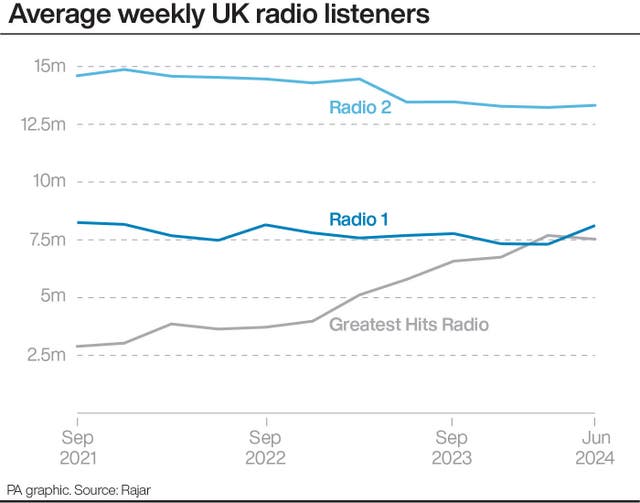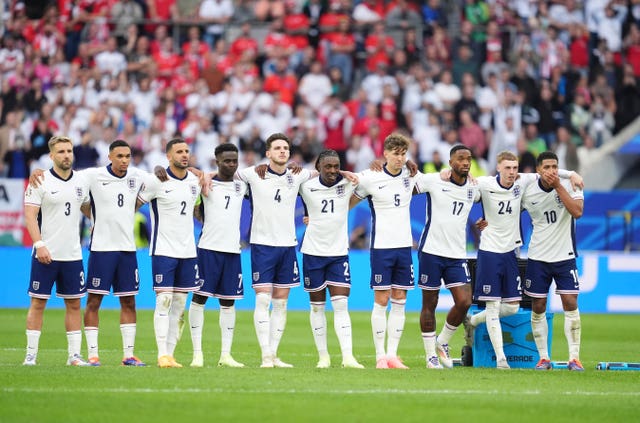BBC’s share of radio listening falls to post-pandemic low
The downward trend looks to have been driven mainly by a slow decline in the number of people listening to local and regional services.

The BBC’s share of the time people spend listening to radio in the UK has fallen to a post-pandemic low, despite some of its flagship stations seeing an increase in audiences, figures show.
The corporation’s stations accounted for 42.6% of radio listening in April to June, down from 43.4% the previous quarter, according to data from research body Rajar.
The figure was 50.9% in July to September 2021 when the reporting of radio listening figures resumed after a break at the start of the Covid-19 pandemic.

The downward trend for the BBC looks to have been driven mainly by a slow decline in the number of people listening to local and regional services.
The average weekly audience for these stations was 7.0 million in April to June, down from 7.7 million 12 months earlier and a drop of more than two million since July-September 2021, when the figure was 9.2 million.
BBC local and regional stations accounted for 4.3% of total radio listening in the latest quarter, compared with 5.7% a year earlier and 6.1% in July-September 2021.
In its annual report for 2023/24, the BBC said efforts to increase the depth and volume of local news stories online had seen an “increase in the size of audiences consuming local news online” but this had “necessarily resulted in schedule changes for audiences across local radio, with more sharing of programmes, off-peak and at weekends”.

Proposals to reorganise its local radio stations to share more content and transmit fewer programmes unique to their areas resulted last year in BBC local journalists going on strike, as well as long-running work-to-rule action, with the dispute formally resolved in November.
Several of the BBC’s flagship stations fared far better in the last quarter, with Radio 1 up by 11%, taking its average weekly audience to 8.1 million.
Coverage of Radio 1’s Big Weekend in May is likely to have contributed to the 812,000 increase in weekly listeners since the previous quarter.
Radio 5 Live enjoyed an increase of 10% on the quarter, bringing its average to 5.4 million, thanks to coverage of major sporting events including the Euro 2024.

After facing turbulence over the departure of veteran presenter Ken Bruce, Radio 2 listenership appears to be holding more steady with an average weekly audience of 13.3 million, similar to its 13.2 million level during the previous quarter and 13.5 million a year ago.
Bruce left the station in March 2023 after more than three decades hosting the mid-morning show, to join Greatest Hits Radio, taking his PopMaster quiz with him.
The commercial station, which is also now home to former BBC DJ Simon Mayo, had been enjoying an increase in listener numbers for the past two years but its rise seems to have slowed as this is the first quarter since June 2022 that its average audience has not increased.
Despite the 2% dip to 7.5 million compared with 7.7 million last quarter, Greatest Hits Radio has still had a 30% increase from the 5.8 million average a year ago.
While some stations across the spectrum have seen drops, the total average weekly radio audience in UK passed 50 million people for the first time since post-pandemic records began.
The steady increase over the last few years suggests there is still a major appetite for radio amid changes to the digital landscape.

The BBC’s chief content officer, Charlotte Moore, said: “I’m delighted to see the strength of the audio landscape with a record number of people listening to radio and podcasts across the UK.”
She also celebrated the increases for Radio 1 and 5 Live as she said there would be “more world class coverage” on sporting events.
Helen Thomas, head of Radio 2, said: “We’re incredibly proud that Radio 2 remains the UK’s favourite station with over 13.3 million people tuning in each week, and delighted that The Zoe Ball Breakfast Show and Vernon Kay on weekday mid-mornings continue to be the UK’s most listened to shows.”
The latest Rajar figures also show:
– The audience for Radio 4’s Today programme was broadly unchanged, with an average of 5.5 million listeners in the most recent quarter, compared with 5.6 million in January to March and 5.5 million a year earlier.
– Zoe Ball’s Radio 2 breakfast show had an average audience of 6.4 million, down from 6.6 million the previous quarter and 6.7 million a year ago.
– Greg James’s breakfast show on Radio 1 held steady with 4.0 million listeners, up from just under four million in the previous three months, with comparable year-on-year figures not available due to a change in the show’s transmission time. This comes after James saw an increase in his salary in the past year to a pay bracket of £415,000 to £419,999 for 2023/24, up from between £395,000 to £399,000 in 2022/23.
– The BBC Asian Network hit a post-pandemic high of 644,000 listeners in the latest quarter, while BBC 1Xtra saw its second highest figure since the pandemic of 829,000.
– Among the smaller speech-based stations, GB News recorded its best quarter since launching in 2022, with an average weekly audience in April to June of 518,000, up from 455,000 in the previous quarter and 317,000 a year earlier.
– Times Radio had an average of 478,000, down on the previous quarter (503,000) and a year ago (523,000), while Talk Radio had an audience of 689,000, also down on the quarter (757,000) and the year (727,000).





